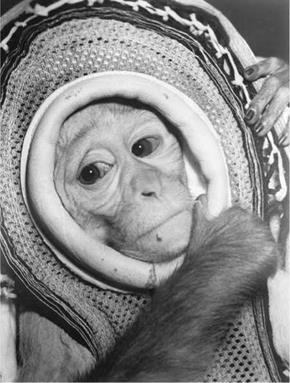A SUCCESSFUL TEST FLIGHT
On 24 March 1961 the weather conditions at Cape Canaveral were favorable for a liftoff that day from Launch Complex 5. The launch procedures had been arranged in a four-hour countdown that began at around 8:30 a. m. (EST). Liftoff had originally
|
Rhesus monkey Miss Sam flew on the LJ-1B abort test flight from Wallops Island. (Photo: NASA) |
been scheduled for 1:00 p. m., but this was advanced by half an hour at the request of the Atlantic Missile Range. The countdown would only involve procedures relative to the MR-5 Redstone booster, as the research and development capsule mounted on top was inert. Everything went smoothly, and the loading of the liquid oxygen began two hours prior to the scheduled launch time.
Including the spacecraft and its escape tower, the MR-BD vehicle stood 83.1 feet tall, and would have a total weight of 66,156 pounds at liftoff. Given the elongated fuel tank and enhanced performance of this Redstone variant, the more powerful but toxic Hydyne fuel was replaced by a mix of 75 percent ethyl alcohol and 25 percent water that would be combined, as previously, with liquid oxygen.
At 12:29:58 p. m. the MR-BD rocket lifted off the launch pad and booster cutoff occurred 141.7 seconds later. No thrust difficulties were encountered as the Redstone climbed to an altitude of 115 miles, attaining a maximum velocity of 5,123 miles an hour. After a flight lasting 8 minutes 23 seconds the entire assembly plunged into the Atlantic 311 miles downrange – almost exactly as planned. The area of impact was only 1.7 miles longer than planned, and less than 3 miles to the right of the envisaged

|
site. As the structure sank swiftly to the floor of the ocean, a SOFAR (sound fixing and ranging) bomb attached to the interior of the capsule automatically detonated at 3,500 feet. This device had been inserted at the request of the Navy for a checkout of its Broad Ocean Area (BOA) Missile Impact System.
All of the test objectives of the MR-BD mission were achieved, and a preliminary analysis of the flight data showed only slight deviations from the ideal performance. All systems functioned as planned and no problem areas were revealed.
“The engine performed perfectly,” Dr. Kurt Debus, NASA’s director of launch operations later explained. “It burned its prescribed time and did not cut off too soon, as on the previous launching.” Debus announced that if a careful analysis of all the post-flight data demonstrated that the Redstone had functioned smoothly, no further tests would be required and that an astronaut would be able to be launched within six weeks to fly approximately the same 15-minute course as had been traveled that day. “However,” he cautioned, “a close look at the tapes might reveal a slight flaw which could necessitate another test Redstone launching.” [15]
Other NASA officials warned against an over-optimistic timetable, emphasizing that a manned flight depended on several other factors. Mercury Operations Director Walter Williams, pointed out that, in particular, the capsule had to undergo further helicopter drop and flotation tests before an astronaut could ride it.











